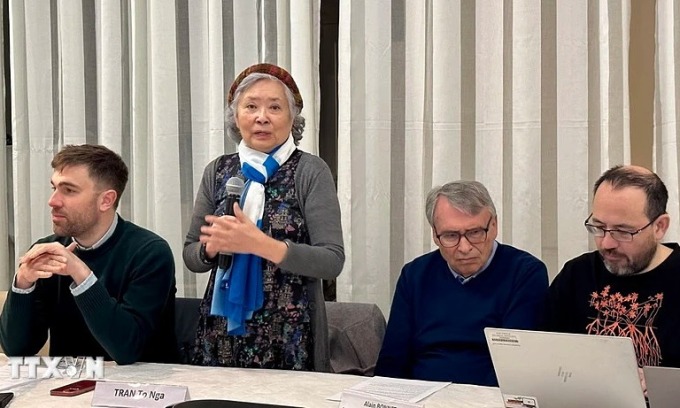HERBICIDES AND DEFOLIANTS
Purpose of the use in Vietnam
During the American war, this was one of the technologies of destruction used by the U.S with the following objectives:
- to destroy the vegetation along roads and trails, on the banks of watercourses in the interior and on the seashore, to facilitate the surveillance of military installations as well as of their environs, in order to clear their perimeter,
- to thin out the forests in the interior, to reveal North Vietnamese camps or hiding places, and
- lastly, to destroy crops in zones held by the Viet Cong.
Use of herbicides for military purposes
During 1943 and 1944, military specialists had tested 12,000 chemical products and adopted 7,000 of them as weapons of war which could be used during conflicts.
In 1945, the Americans drew up a plan of spraying products able to destroy harvests on the paddy fields surrounding large Japanese population centers, but the end of the war against Japan came before this program could be implemented.
The use of defoliants and herbicides in Vietnam
In 1960s, the U.S Government, increasingly involved in Indochina, had to cope with popular uprisings and with the growth of a revolutionary movement in South Vietnam. In the context of the Stanley-Taylor plan to pacify the country and to gain control of roads and watercourses, it envisaged, with the agreement of the Ngo Dinh Diem regime, the use of defoliants and herbicides, the best known of which, used in Vietnam, would be Agent Orange. By extension, various herbicides and defoliants are sometimes called Agent Orange in some popular articles, although they are chemically very different from one another and possess different degrees of toxicity.
On 11 May 1961 during a meeting of the National Security Council, President Kennedy secured the Council\'s consent to provide assistance to the South Vietnam government via the creation of a War Equipment Development and Testing Center and authorized the testing of herbicides and defoliants on the Laos/Vietnam border area, a particularly sensitive zone.
Defoliation, code-named first Operation Trail Dust, became, with respect to its principal, aerial component, Operation Hades, the ancient Greek god of the dead and of the underworld, and was later re-baptized Operation Ranch Hand, a more polite and less aggressive name.
The first spraying operation took place in August 1961, but the proper operation, decided on by the American government in 1961 during the Kennedy administration, did not really begin until 1962. It continued during the Johnson presidency and did not end until 1971 during the Nixon administration as a result of public opinion pressure and the protests of scientists of various countries, but essentially American ones.
What is Agent Orange?
Agent Orange is a herbicide (actually pink brownish), which received its name from the orange band painted on the product\'s cans in order to identify it and to distinguish it from other herbicides called Agents white, blue, purple, pink or green. This discreet, almost innocent and indeed poetic nomenclature for highly toxic products, recalls the \"special cans\", containing napalm, used elsewhere and in other times.
In chemical terms, Agent Orange is a mixture of equal parts of 2,4-D and 2,4,5-T, with dioxin as a by-product of its manufacture at a dose of between 3 and 4 mg/liter, but much higher in the case of large-scale or accelerated manufacture.
WHAT IS DIOXIN OR, MORE APPROPRIATELY, WHAT ARE DIOXINS?
Chemistry
Dioxin, sometimes called Seveso (which is the name of the town in Italy, near Milan, where an accident occurred in July 1976 in the Ecmesa factory in a chemical reactor producing chlorophenol, with the emission of vapors containing dioxin), is a chemical product whose chemical formula is 2,3,7,8-tetra-chloro-dibenzo-para-dioxin or TCDD.
For the more curious readers, there are, depending on the spatial arrangement and the number of chlorine atoms in the basic structure, 75 congeneric products (of a similar chemical structure) of PCDD (polychloro-dibenzo-dioxins) and 135 of PCDF, a close group of polychloro-dibenzo- furanes of varying toxicity and other related products, PCB\'s (polychloro-biphenyls), which are dioxin-like, 419 chemical products in all, 29 of which are particularly dangerous, the most toxic being TCDD.
Physico-chemical properties of dioxin
This product is particularly stable, heat-resistant up to 1000°C and indeed higher, only slightly soluble in water, but is liposoluble, that is to say, soluble in greases and which is therefore able to accumulate in various tissues or fluids of living organisms, human or animal and particularly in mothers\' milk, leading to the risk of transmission to nursing infants.
Noxiousness of dioxin
Dioxin is harmful to living beings, both human and animal, even at infinitesimally small doses. Experimentally in the laboratory, the lethal (mortal) dose for rodents or fish is of the order of micrograms, that is to say, millionths of a gram (10‘6 g) per kilogram of body weight and doses of nanograms (one billionth of a gram (10\'9 g) can bring about miscarriages, premature births and births of monstrosities. Long-term exposure to dioxin causes cancers in laboratory animals.
The lethal dose for a human being, which has not been determined with precision, would be 0.1 mg/kg in the case of massive poisoning, as in the Seveso accident or during direct spraying in Vietnam. On the other hand, a lesser but extended daily poisoning of any individual may entail health problems as indicated later.
Half-life of dioxin
Half-life is the time needed for half of a substance to disappear, either by being destroyed, or becoming inactive. In the case of dioxin, half-life was initially estimated at 3 years, then at between 7 and 8.2 years, but in living beings and in the sediment of rivers and lakes, it is thought to be longer, 10 to 17 years. In any event, over 30 years after the end of its use in Vietnam, a not negligible quantity remains in certain specific zones or hot spots (see below).
Course of action of dioxin
It has been shown that the toxic effects of dioxin come about by its taking part in a complex molecular process in cells, in particular reproductive cells, and necessitate the participation of a specific receptor called Ahr (aryl hydrocarbon receptor), which would be 10 to 15 times more sensitive in rodents used in laboratories than in human beings. An extrapolation of the results is therefore not possible and any results would be debatable.
There are still many \"unknowns\" in the chain of cellular chemical reactions and the results of various studies, sometimes contradictory, do not make it possible to reach any certain conclusions concerning the toxic role played by dioxin in all the pathologies where it is nevertheless suspected of being involved.
An Australian study during the 1990s, for example, found no link between dioxin and cancer in human beings. Certain research scientists are less categorical, others more affirmative regarding the connection.
Where does dioxin appear?
It may appear during natural phenomena such as volcanic eruptions, forest fires, or during human activities such as the manufacture of iron and steel, the bleaching of paper pulp, the manufacture of bleach, the recycling of nonferrous metals, the operation of power stations, the incineration of household waste, the burning of peat, or as a by-product, that is to say as an undesirable, but unavoidable part of the production of chemical substances, including pesticides and most importantly, of herbicides. In fact, all natural or human activities involving high temperatures and the presence of chlorine atoms may involve the production of dioxins or of furans (chemical products similar to dioxins, with only one oxygen atom instead of two and of lower toxicity, the principal one being 2,3,7,8 tetrachloro-dibenzo- furan).
Effects of dioxin
Direct, accidental or intentional exposure produces effects which depend on the quantity of the toxic substance and the duration of exposure, assessed scientifically in terms of toxicity equivalents (TEQ - international codification in 1989) and may cause directly discernible lesions, such as skin lesions recalling acne (chloracne), or dark diffuse spots, later and more covert alterations of the hepatic function, an alteration of the immune system, various cancers, an endocrine gland dysfunction and an alteration of the reproductive function in both men and women.
According to the Encyclopedia Britannica (1), dioxin is a stable compound which accumulates in the environment, is toxic, carcinogenic and teratogenic (producing malformations in newborn children) during animal experiments.
Contamination routes
- The aerial route, in the case of direct massive spraying or prolonged stays in a chronically polluted zone.
- The transcutaneous route, but repeated contact is necessary.
- The digestive route through the contamination of the food chain, including mothers\' milk, cows\' milk, the consumption of contaminated meat or fish, which
1. London, 1998 edition printed in the USA. concentrate dioxin in their various fatty deposits or tissues.
Metabolism or the fate of dioxin in a living organism
Dioxin absorbed with food passes into the bloodstream, accumulates in the liver and the muscles and slowly accumulates in fatty tissues. Eliminated by the gallbladder, it is liable to be partially reabsorbed by the intestines and its elimination is accordingly very slow.
In pregnant women, dioxin may be transmitted to the fetus through the placenta and in the mother enter her milk and thus into nursing infants. Side effects occurring more or less later may appear in the fetus, the nursing infant or the child, who are particularly sensitive to these molecules.
Through analogous processes, dioxin may enter the eggs of hens, ducks and other birds and the progeny of various domestic and wild animals.
Particularly exposed populations
The populations exposed vary from period to period and according to precautions taken in the light of increasing knowledge: chemical factory personnel, farmers and all persons using herbicides and defoliants, paper pulp industry and domestic waste incineration professionals and lastly populations subjected to spraying for military purposes as in Vietnam, Laos and Cambodia between 1961 and 1971 and even 1971 and 1975, where the most vulnerable appeared and still appear to be fetuses and nursing infants and therefore the generations following the generation contemporary with the war.
Has the toxicity of dioxin resulted in accidents?
In 1957, this toxicity was apparent in an herbicidemanufacturing factory in Germany in workers, whose skin showed signs of being allergic to products containing dioxin and in farmers using herbicides.
Then there were accidents in the industrial manufacturing of certain chemical products, the best-known being that at Seveso in Italy in July 1976, at Yusho in Japan and at Yu Cheng in Taiwan, with several thousand persons more or less seriously poisoned (37,000 at Seveso), presenting direct or secondary health-related consequences.
It should be noted that at Seveso several years after the accident, genetic mutation occurred in mice, without alteration of reproductive cell chromosomes, but by exchanges of pairs of chromosomes and therefore, in fact, by the creation of a new species[1].
Finally, the spraying of herbicides and of defoliants in Vietnam produced, apart from effects on the environment, the poisoning of both the Vietnamese civilian population and of both Vietnamese and American and allied military personnel. Despite terrible effects, the government of the U.S still used highly dangerous products, whose noxiousness was being proclaimed by scientists of various nationalities, including Americans.
[1] According to Professor Redi, of the University of Pavia, in a communication in 2000.



_thumb_720.jpg)








_thumb_720.jpg)



















Comment